Does your garden look dull in winter? Do you want to plant beautiful flowering plants in your garden in winter? Well, you’ve come to the right place to know what flower plants you can grow in your garden in the winter season in India.
To help you protect your garden from the falling temperature in winter, I’m going to give you information about some winter plants in India that you can grow easily. I will state how much time they take to bloom, at what temperature they can bloom, what they need to bloom correctly, and how you can take care of them.
People also love to read: Flowers that mean love
Winter is different in various regions of India. In the Southern States of India, the climate is quite moderate in winter; meanwhile, in Central Indian states, the weather is moderate, and in the Himalayan states, people experience much colder weather.
It doesn’t matter which region you live in; you’ll have to save your garden from looking like a graveyard everywhere. To do that, you can grow different kinds of exquisite flower plants that bloom in winter, and without any further discussion, let’s see which plants you can grow.
Overview Of Winter Flowers In India
| Plant Name | Fertilization Temperature (°C) | Fertilization Days | Blooming Time |
| Antirrhinum | 12-21 | 10-21 | 2-3 Months |
| Calendula | 15-25 | 7-10 | 45-60 Days |
| Cosmos | 21-25 | 5-10 | 2 Months |
| Cineraria | 15-21 | 7-14 | 2-3 Months |
| Carnation | 15-23 | 14-21 | 100-120 Days |
| Daffodils | 12-25 | 10-15 | 70-100 Days |
| Fuchsia | 21-25 | 21-28 | 18 Months |
| Hollyhock | 15-21 | 10-14 | 1 Year |
| Primrose | 10-21 | 10-21 | 4-5 Months |
| Pansy | 18-23 | 10-14 | 3-4 Months |
Antirrhinum
Antirrhinum is mainly known as snapdragon or dog plant in India. Antirrhinum is its scientific name. People call it a dragon flower or snapdragon because the shape of this flower is similar to a dragon’s face, and when you squeeze the flower, it closes its mouth. This flower usually is crimson, yellow, or white in color.
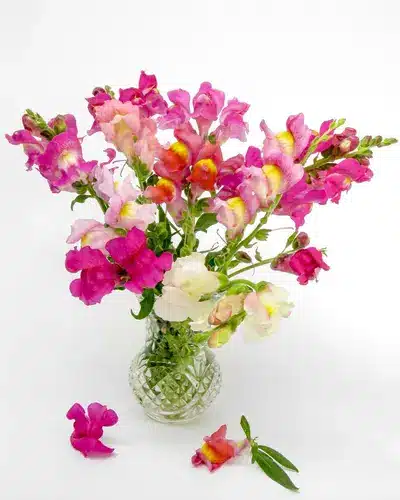
Antirrhinum usually grows in rocky areas of Europe, the U.S., Canada, and North Africa. Let’s see how we can plant it right in our garden.
- How To Plant:
To see a fully bloomed flower in winter, you must sow antirrhinum seeds in autumn. Firstly you’ll need to sow the seeds thinly on the surface of the manure and water and seal it in a clear plastic bag. When the seeds become large enough to handle, transfer them into a pot and place them in a sheltered place to grow.
- How To Take care:
Snapdragons are usually pests and disease free, which solves a significant problem. Feed them weekly with a potassium-rich fertilizer to keep the flowers alive for an extended period. Water them regularly, and place a cane for taller plants to support them.
Calendula
People also know calendula as pot marigold. It is one of the most perfect and beautiful winter plants in India also, it is very easy to plant in the wintertime. It doesn’t have any strong fragrance but a mild scent that gives you a refreshing feeling.
The flower is yellow in color. Beautiful bright yellow color lights up the whole garden and makes the garden look tremendous. It is generally used for medical and culinary purposes. Calendula is also known as “poor man’s saffron” because people can eat the petals of this beautiful flower.
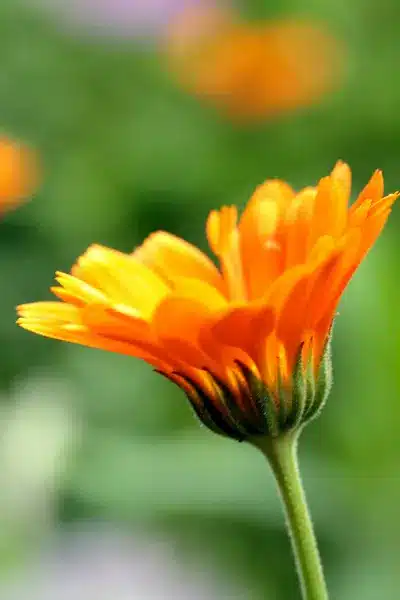
People can use it fresh in a salad, dried up in cheese, or add it to soup or stews for color. The taste of this flower is mildly sweet. The flavor intensifies when the flower is dried up. It is one of the most useful winter plants in India.
- How To Plant:
Seeds of calendula can be sown without special treatments like soaking or stratification. You can sow the seeds directly in the garden thinly or in patches.
First, you need to mark a row where you want to grow the flowers, then drop seeds 6 inches apart. Cover the seeds with ¼ soil and pat gently.
- How To Take Care:
Calendulas don’t need much caring. It can grow fine without any extra care. In fact, too much care can slow the growth of this flower.
Calendulas are adaptable herbs, so they don’t need high maintenance. Only well-draining soil and occasional watering are the secret to growing perfect Calendulas. It is ideal for growing in winter as the flower prefers cool temperatures.
Cosmos
Cosmos are usually 0.3-2m or 6 feet tall and pink, orange, yellow, and maroon in color. These are daisy-like flowers that you can grow in the winter season as they prefer dry soil. Cosmos flowerheads are either bowl-shaped or open-cup shaped.
Cosmos grows in scrub and meadowland in Mexico. The flower is also widely spread over the high eastern plains of South Africa.
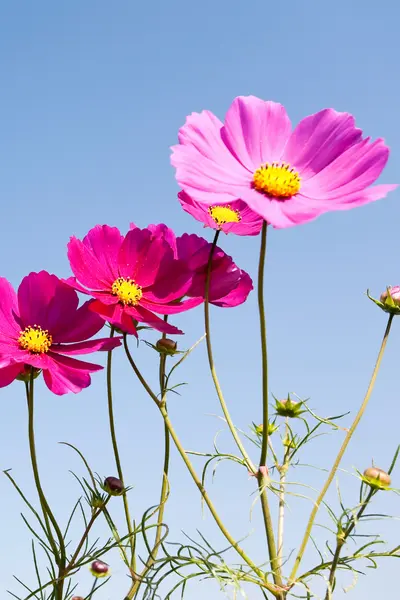
- How To Plant:
Make sure you plant the flower plants in soil that isn’t heavily repaired. The optimum growing conditions of the cosmos are hot, dry conditions and poor to average soil.
To grow the flowering plant, first spread the seeds on a bare area in the spot you’ve chosen to grow the flower. The annual flower self-seeds and will provide you with more cosmos flowers.
- How To Take Care:
To take care of cosmos flowers, you’ll need to water them regularly and add a mulch to help conserve the moisture. And during the growing season, stake and tie the plants if it’s necessary.
Cineraria
This flower usually grows in South Africa. It is a hybrid plant, a mix of Pericallis cruenta and P. lanata. It is known for its vibrating color and long-lasting blooms.
Cineraria usually comes in pink, red, purple, and blue colors. It’s a plant with large petals. Cineraria is a winter plant because it prefers cool weather to bloom. The flower is usually 6-12 inches tall.
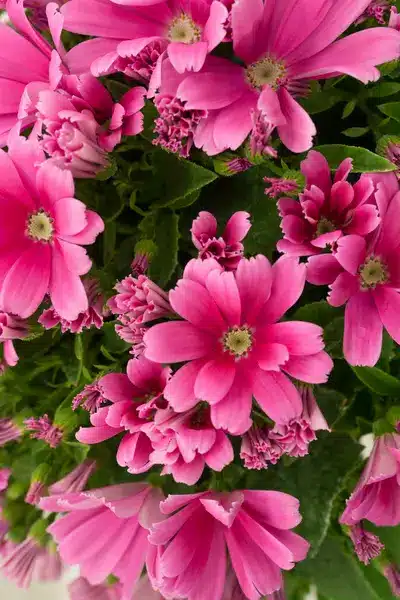
- How To Plant:
To plant the cineraria flower, take a pot and fill it with good-quality manure in the soil with a ratio of 2:1. Then, put two seeds at the bottom of the pot and cover it up with soil and pat it slightly with your fingers.
- How To Take Care:
Plant the flowers where they get partial sunlight or less light. Cineraria best grows in rich, moist, and slightly acidic soil. Water the plants regularly but make sure it doesn’t become soggy.
Carnation
Carnation flowers are very colorful and have a pleasantly refreshing fragrance. They are also known as grenadine or clove pink.
The flower has lovely fringe petals that give it an eye-soothing look. The leaves of this flower are bluish-green and narrow in size. The flower is usually 30 to 75 cm tall.
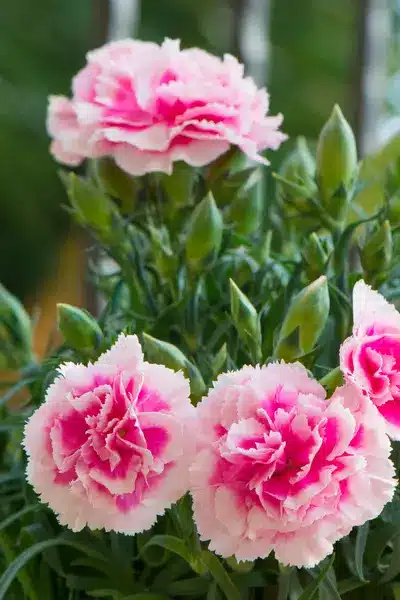
Because of its exquisite looks, the flower is used to decorate places, arrangements, and corsages. It doubles up the beauty wherever it gets used. Another vital thing about this flower is that it is mildly toxic to animals. So keep your pets away from carnation flowers.
- How To Plant:
Plant the carnation seeds in a soil mix that is well-drained, an eighth of an inch deep. Make sure to spread the seeds 12 inches apart from each other. Don’t overwater the seeds.
- How To Take Care:
Carnations don’t need mulch to grow, but if you still want to use mulch, then go for a natural product rather than dyed mulch.
Make sure to put carnations under partial shade, as too much bright afternoon sun can fade the color of the petals.
Carnation best grows when you use well drainage and alkaline soil. These flowers can also bloom during a drought, so they don’t need much water. But water them regularly when their flower buds are forming.
Daffodils
The Latin name of daffodils is narcissus, and it’s an ancient flower. It is the perfect flower for your garden in the winter season. It comes in bright colors like yellow and white.
Daffodils are used as medicines in traditional and folk medicine. It is also used as a medicine to cure cancer in many places. It can be used as a vomiting-reducing supplement.
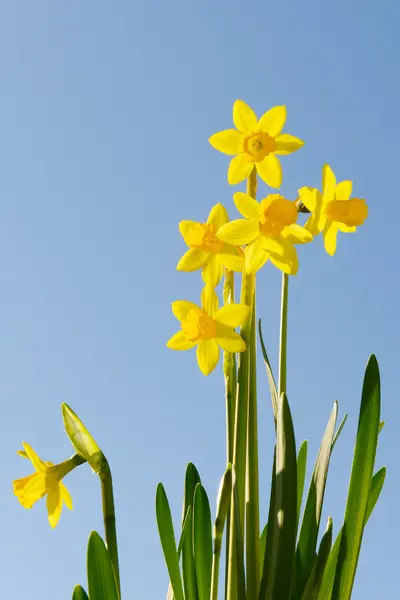
- How To Plant:
Grow daffodils in a place where they’ll have shade and not be exposed to the sunlight much. Sow the daffodil seeds 3-6 inches deep in the soil. Put each seed 4-5 inches apart. Place the bulbs on the ground with their pointy ends upwards.
- How To Take Care:
Water the plants constantly in their growing period. You have to water them instantly after sowing and keep them moist until it rains.
You don’t need to keep the plants wet when well-grown. Check the plants and water them according to their needs.
Fuchsia
Fuchsia flowers are brightly colored and shaped like a tear-drop. When fuchsia blooms fully, it looks like a chandelier with many beautiful flowers hanging down.
By planting fuchsia flowers in your garden, you can invite many hummingbirds into your garden because fuchsias are very likable to hummingbirds.

Fuchsia plants are 1 to 2 feet tall and come in pink, red, white, violet, and maroon colors. When it is appropriately bloomed, it fills your garden with an ineffable beauty.
- How To Plant:
To plant fuchsia, you’ll need to make a mixture of peat moss, potting soil, and vermiculite in a pot and put the seeds in the mix. Cover the seeds with a thin soil layer and the pot with loose plastic. The soil should be moist and not soggy.
Put the base of the stem of fuchsias 5 cm below the soil surface so that it protects the crown of the plant during cold weather.
- How To Take Care:
Fuchsias love to grow in a hydrating atmosphere. It thrives in humidity. So if you live in a dry place, ensure you water fuchsias constantly but don’t make the soil soggy.
During the blooming season, fuchsias stay hungry for more food. So feed them regularly with diluted liquid fertilizer.
Hollyhock
Hollyhocks are generally seen beside a barn, in front of a cute cottage, or lining a white picket fence. They are very adorable flowers with a sweet scent.
This flower comes in blue, oranger, pink, purple, red, white, and yellow colors. It is 3 to 8 feet tall and 1 to 3 feet wide.
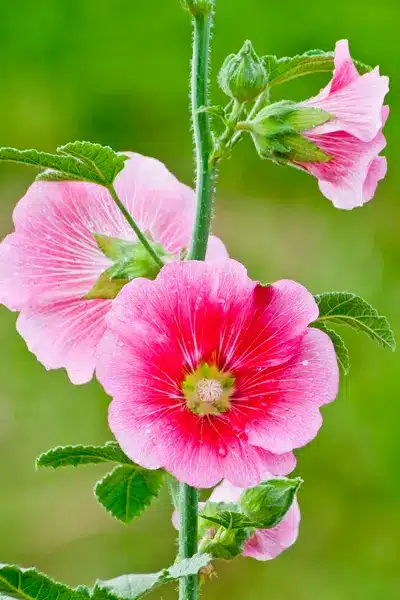
After growing fully, the flowers may open simultaneously to create beautiful columns of color that range from yellow to pink to white.
- How To Plant:
Sow the seeds of the hollyhock ¼ inches deep into the soil. Put the seeds 2 feet apart. Make sure to give each plant enough place to spread because hollyhocks spread enormously.
- How To Take Care:
Hollyhocks can grow ideally under low maintenance. You’ll need to protect the plant from wind and trim foliage when it’s needed.
When you plant the hollyhock, water them constantly. In its growing period, water them according to need and don’t water the leaves as wet leaves can cause rust.
Primrose
Primrose is a small plant that grows to a minimum of 10 cm in length and comes in red, pink, orange, yellow, blue, purple, and white colors. It is usually found in woodland clearings and grassland.
The leaves of this plant are wrinkly with hairy undersides. The flower is usually pale to deep yellow with a darker yellow-orange center. It’s one of the most beautiful winter flowers in India.
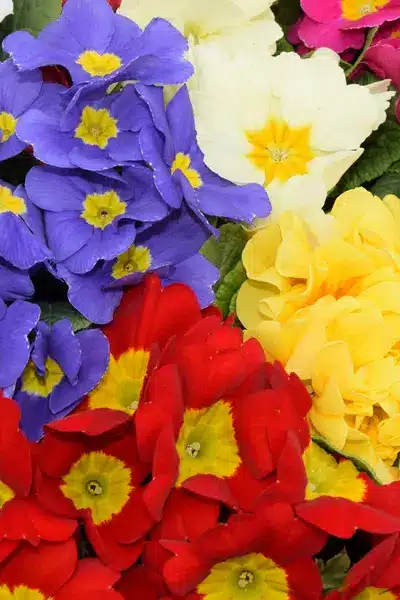
You can find primroses in Britain and Ireland as it’s widespread in those places. It’s an annual plant.
- How To Plant:
When choosing a place to plant primrose, select a light-shaded area with well-drained soil. Place the primrose seeds 4-6 inches deep into the soil and spread them 6-12 inches apart from each other. Water them properly after planting and add a layer of good quality mulch around the plants to increase the moisture.
- How To Take Care:
Primrose plants that are hybrid are immensely thirsty. They need regular watering to stay alive. They also need half-strength liquid fertilizer to bloom.
Pansy
Pansy is a plant that consists of large flowers and is a hybrid plant. Pansies are actually short-lived perennials that are popular in colorful pots and border displays. Pansies are 6 to 9 inches tall plants. The flower comes in blue, orange, pink, purple, red, and white colors.
A great fact about pansies is that the flower is edible and can be used to decorate cakes and garnish cocktails. These are considered the floral version of lettuce.
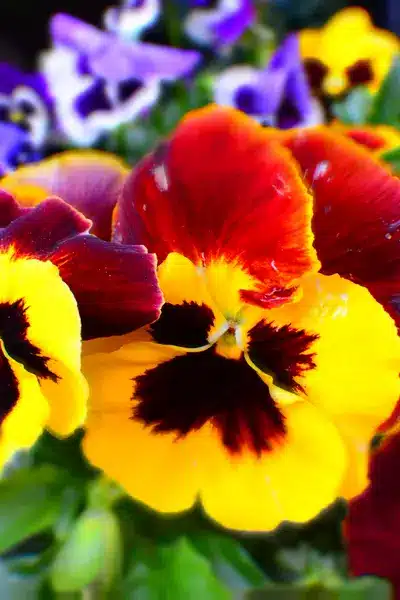
- How To Plant:
Pansy seeds need to be sowed 7 to 12 inches apart as they will spread widely from 9 to 12 inches in size.
- How To Take Care:
Pansies are very easy to take care of and are long-term garden decorators. They need rich, well-drained soil with proper moisture. You have to keep pansy plants watered during dry weather. Ensure you’re pouring water into the soil, not the leaves. It’ll help to avoid any fungal diseases. Feed the plants with liquid fertilizer.
Conclusion
It is not easy to keep the garden alive and beautiful in winter because most plants get dried up during winter. That’s why I have listed some beautiful, bright-colored winter plants in India so that you can save your garden from looking like a mess.
If you live in India and are facing the problem of the garden getting destroyed during winter, then you can choose any of the listed flowers to keep your garden as beautiful as it is.

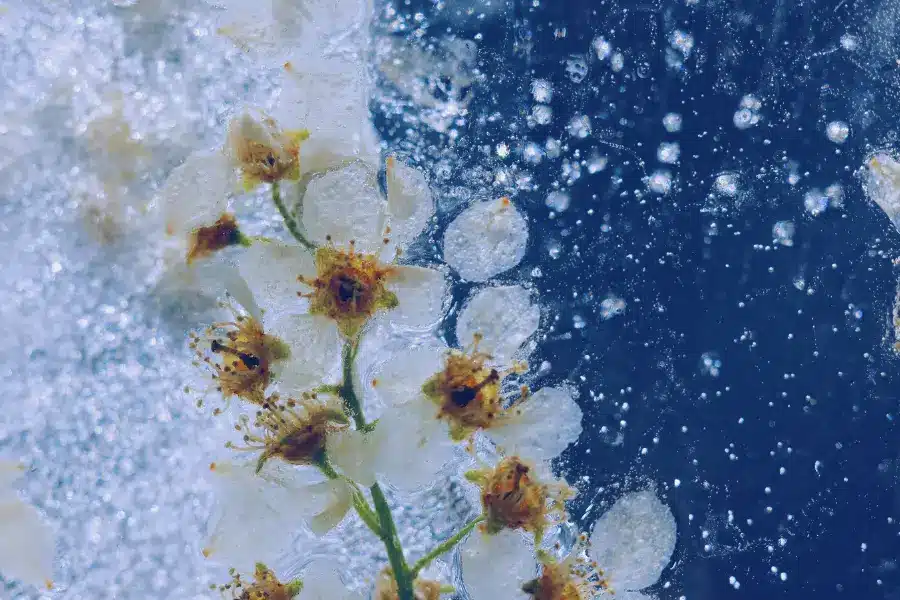

![10 Best Bags for Nurses | Personal Recommendation [2023] 14 Best Bags For Nurses Reviews in 2021](https://knowworldnow.com/wp-content/uploads/2022/12/Best-Bags-For-Nurses-Reviews-in-2021.webp)



![F95Zone Games - The Ultimate Guide for 2021 [F95Z Guide] 18 F95Zone Games](https://knowworldnow.com/wp-content/uploads/2021/07/ArTtW5LrK3b-z-0-y-637f48d86203817a9042a857.webp)